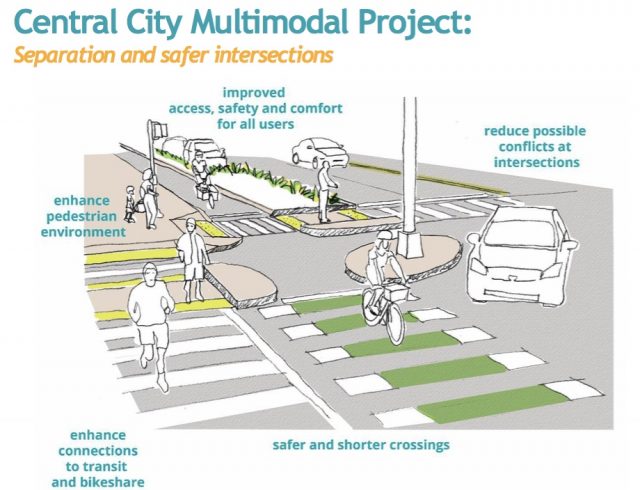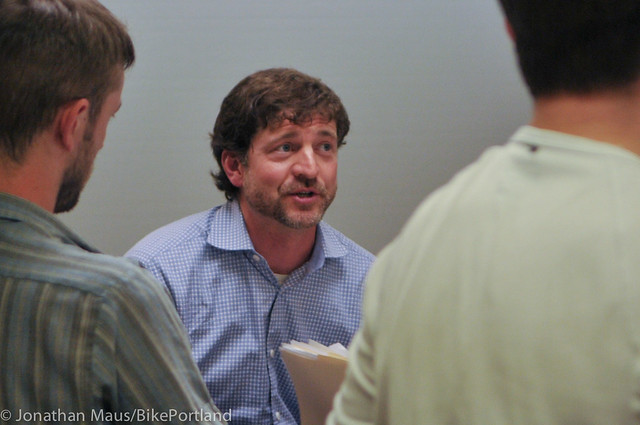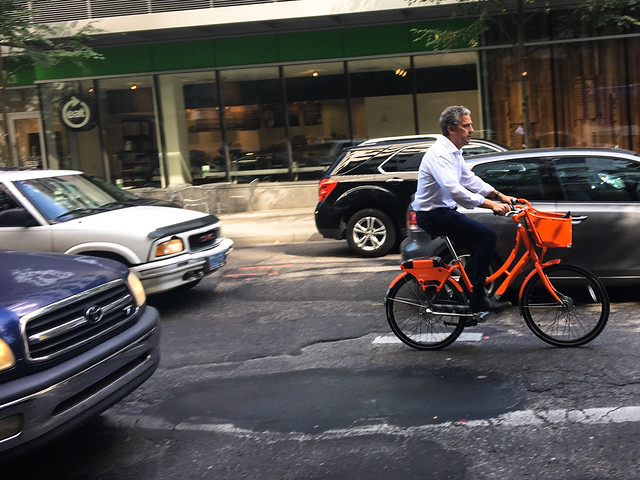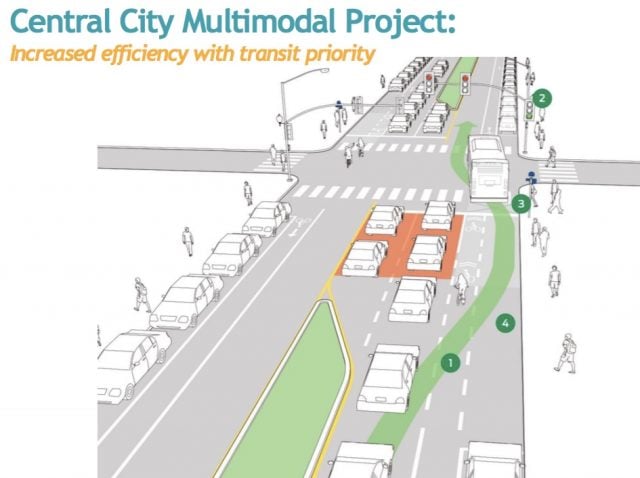Today at Portland city council our transportation bureau took another step forward in a project that will finally build separated bikeways and other street upgrades in the central city.
“We’re at that moment right now where people are fighting their way through the congestion instead of just realizing it’s going to take five extra minutes to get through downtown because we’re a bigger city now.”
— Art Pearce, PBOT
But before we go any further. Please take a few minutes and fill out PBOT early input survey.
Ok. Thanks. As we were saying…
PBOT’s Central City Multimodal Project finally got the go-ahead from the Oregon Department of Transportation to begin public outreach and planning. PBOT project managers shared a presentation about the project with council members today in advance of formally accepting a $852,000 payment as part of an intergovernmental agreement with ODOT.
Thanks to a $6 million federal grant (via Metro) and $2.8 million from the recently passed local gas tax, Portland will spend $8.4 million, “to help make getting to and around the Central City safer, easier, and more convenient by foot, bike, and transit.”
While the public process for deciding where to put new bikeways, transit-only lanes, new plazas, and so on, hasn’t started, PBOT has already been meeting and making presentations about the project to various city advisory committees and a few select powerful stakeholders like the Portland Business Alliance, the Central Eastside Industrial Council, Travel Portland, and others.
Today at city council we got a peek at how PBOT will frame this crucial project, how council feels about it, and a few more nuggets. Here’s what we learned.
Downtown Neighborhood Association is pumped
While we’re concerned at how PBOT has private meetings with certain stakeholders prior to opening up the process to all citizens, they also use these meetings to line up key early support. Today at council they brought Rani Boyle, the chair of the land-use and transportation committee of the Downtown Neighborhood Association, along to testify on the project’s behalf. And she was psyched.
“We are extremely excited about this project,” Boyle said. She continued to say that many downtown residents don’t own cars and want to walk and bike as much as possible, “but they want to feel safer.” “Too often people have very personal stroies of close calls and injuries… and I’d like to hear less of them.”
Advertisement
PBOT gets it
Watching the council meeting today we were pleased with the tone and framing we heard from two top PBOT staffers: Planning Manager Art Pearce and Capital Projects Manager Gabriel Graff. They have a well thought out and strong case from all the angles: statistics, economics, demographics, planning, and so on.
Pearce understands that Portland is changing and we need to change our streets as a result. Here are some of the comments he made today:
“We’ve been waiting and the constituents have been waiting for this process to get started, so we’re excited to get this underway…
Central cities around the world are re-inventing themselves and the Portland central city needs to think of itself as an evolving place that needs to continue to be competitive with central cities throughout the world…
[This project is a way] to make the central city vibrant and grow and include more residents and employees in a way we can really be proud of.”
And Gabriel Graff gave a short slide presentation (PDF). He talked about the need for improved safety and pointed out that 20 of the 40 high crash intersections for people on bike and foot are in the central city. I also really liked that Graff said the project is just about safer trips, but more trips. One of the best arguments against private motor vehicle use in the central city is that it simply doesn’t pencil out mathematically in terms of space.
Here are a few more of his comments:
“The central city is home to the densest concentration of people and jobs in the state. It’s the region’s economic hub… 30 percent of Portland’s growth will happen in this boundary which has just 3 percent of the land… 37,000 new households, 51,000 new jobs… How can we safely and efficiently get people to these jobs as Portland grows?
We see this project as one of PBOT’s first significant investments in our vision for growth.”
The Biketown effect: Bike share is now a major political force
Biketown changes everything. We’ve been saying that for years and now that it’s here we’re seeing the impacts in real life.
Today Commissioner Nick Fish brought up Biketown on his own accord to share that, “My impression is that the launch of these bikes has been a huge success.” The fact that Fish, completely unsolicited, shared his view about bike share in this context is crucial. Those orange bikes make pushing for bike infrastructure so much easier!
And even Commissioner Amanda Fritz shared a bike share comment. “I’m very pleased it’s working,” she said. But as you might expect, she then added how she’s “very concerned” that many people use bike share without helmets and that, “they continue to ride as other cyclists do on the sidewalks downtown.”
Commissioner Fish, the built environment and behavior change
In the most interesting exchange of the day, Commissioner Fish shared a story about getting flipped off for calling out someone’s dangerous driving while he was walking downtown. “I feel particularly vulnerable in light of the terrible tragedy that recently happened on Hawthorne,” he said.
And then he said,
“It struck me there are limits to what we can accomplish through legislating. We can legislate all we want, but some of the beahviors we’re talking about — cars and bikes observing the laws of the road, stopping at red lights, not accelerating when the light is yellow, putting people at risk — beyond changes in road design and these improvements you’re talking about, what’s missing in terms of getting the message to people that irresponsible and dangerous behavior on our streets is not tolerated? Whether you’re in a car or on a bike?
PBOT’s Pearce had a great and quite interesting answer:
“Portland is at a place in its evolution where we’re growing up as a city and this [bad behaviors] is part of that. We’re experiencimng more congestion and more conflicts as we navigate the streets on a daily basis. Your initial reaction to that is to try and navigate through [the congestion], and that’s actually accelerating those conflicts.
We need to develop a culture where people start to understand that as a city gets larger it takes more time to traverse through the city. We’re at that moment right now where people are fighting their way through the congestion instead of just realizing it’s going to take five extra minutes to get through downtown because we’re a bigger city now.”
(Keep in mind Pearce is saying this to Fish — the man who recently complained about how livable streets projects are making it harder for him to drive downtown.)
“Are we going to win that fight through friendly persuasion or through a bigger stick?” Fish quickly retorted. “What has to happen for us to get people to think twice about their behavior?”
Pearce then mentioned enforcement and informational campaigns, and how biking, walking, and transit infrastructure investments will eventually encourage people to drive less and allow us to “turn the tide on congestion.”
Fish seems to think there are only two ways to combat bad behavior: education and enforcement. What he’s missing is this: the built environment has a large, immediate and direct impact on human behavior. As we build more humane streets, people will behave in a more civil and respectful way.
Our streets will have more “clear spaces”
PBOT also shared a few sketches of what the new street designs will look like. Graff described the designs as having “clearer spaces” that will “acknowledge and reduce all of the conflicts that arise at intersections.” On the newly designed streets every user will have “clearly delineated spaces for travel,” he said.
Here are a few samples from his presentation:
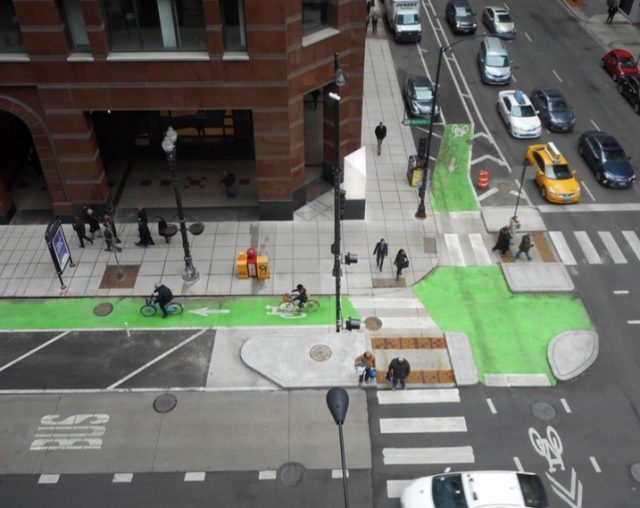
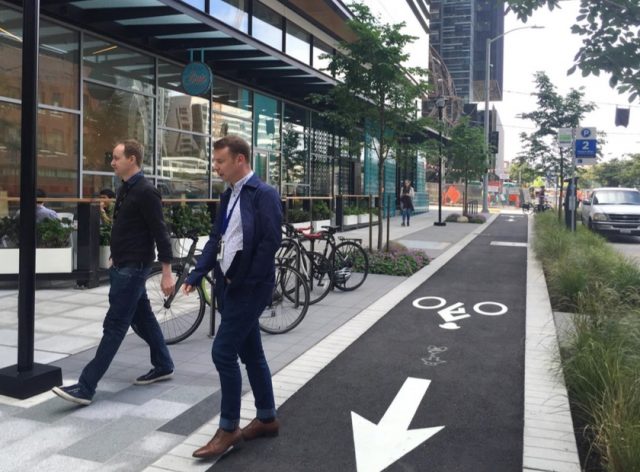
Graff said that this project will continue Portland’s legacy of constantly “evolving” streets. He also showed images of carfree public plazas and the Indianapolis Cultural Trail as an example of how Portland needs marquee bike path projects that will stimulate the economy and engage tourists and locals alike.
The timeline from here is to spend the rest of this summer doing public outreach and forming an advisory committee. Then 2017 will be spent on planning and development and construction will begin in 2018.
Stay tuned. And remember to take that survey.
— Jonathan Maus, (503) 706-8804 – jonathan@bikeportland.org
BikePortland is supported by the community (that means you!). Please become a subscriber or make a donation today.

